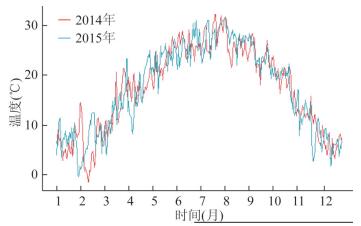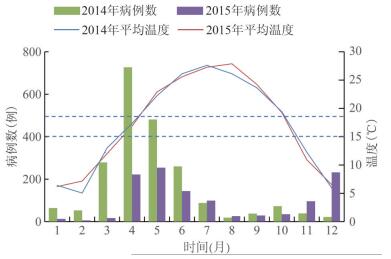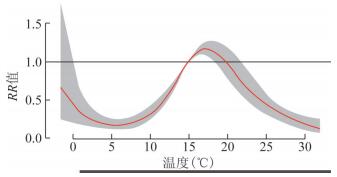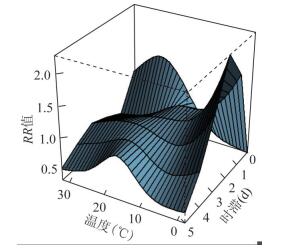扩展功能
文章信息
- 赵球平, 李旭东, 王悦, 鲍俊哲, Aristotle Sun
- Zhao Qiuping, Li Xudong, Wang Yue, Bao Junzhe, Aristotle Sun
- 2014-2015年湖北省仙桃市气温与手足口病报告发病关联性分析
- Analysis on influence of air temperature on incidence of hand, foot and mouth disease in Xiantao, Hubei, 2014-2015
- 疾病监测, 2018, 33(6): 469-472
- Disease Surveillance, 2018, 33(6): 469-472
- 10.3784/j.issn.1003-9961.2018.06.007
-
文章历史
- 收稿日期:2018-03-30
2. 仙桃市疾病预防控制中心, 湖北 仙桃 433000;
3. 中山大学公共卫生学院卫生管理学系, 广东 广州 510080;
4. UW Medicine Valley Medical Center, RentonWA 98055, 伦敦, 英国
2. Xiantao County Center for Disease Control and Prevention, Xiantao 433000, Hubei, China;
3. Department of Health Policy and Management, School of Public Health, Zhongshan University, Guangzhou 510080, Guangdong, China;
4. UW Medicine Valley Medical Center, WA 98055, Renton, UK
自2008年我国手足口病(hand,foot and mouth disease,HFMD)纳入法定丙类传染病以来,其发病比例较高,是近年来重点防控的疾病。其发病水平受气象等多种因素影响,包括温度、湿度、降雨量、风速、气压等[1]。手足口病是由人肠道病毒引起的一种儿童常见传染病[2],发病具有明显季节特征,一般5-7月为发病高峰。本研究通过分布滞后非线性模型(DLNM)初步探讨气温对手足口病的发病影响,为开展疾病防控及病因研究提供参考依据。
1 资料与方法 1.1 研究区域概况仙桃市位于湖北省中部的江汉平原,地处112°55′ ~113°49′ E、30°04′~30°32′N,境内坑溏密布,沟渠交错成网,互相连接。气候四季分明,雨量丰富,阳光充足,属亚热带季风性湿润气候。年平均气温16~17 ℃,7月最高气温达39 ℃,月平均气温28~30 ℃,1月平均气温3~5 ℃,最低气温可低至-10 ℃以下。全年降雨量约1 200 mm,主要集中于春夏季,平均湿度75.86%。
1.2 资料来源仙桃市2014-2015年度气象数据库(最低气温、最高气温、平均气温、相对湿度、降雨量)来自于仙桃市气象局。同年手足口病发病资料来源于当地疾病监测数据库、传染病报告信息管理系统。病例定义按照《手足口病诊疗指南(2013版)》进行分类包括临床诊断病例、确诊病例、轻症病例和重症病例。
1.3 DLNM的应用采用DLNM评估每日平均温度对手足口病的发病影响。DLNM可同时研究死亡和部分危险因素,如气温或空气污染的非线性关系和危险因素对发病、死亡的滞后效应,该模型是对一些传统分布延迟模型的进一步发展。在分析温度-发病关系时,同时排除星期几效应(day of the week,DOW),相对湿度和降雨量的可能影响。分析公式如下:
LogE[Yt]= α + βTt,l+ NS(RHt,df = 3)+ NS(Rainfall,df = 3)+ DOWt
式中E[Yt]表示特定日期t出现的每日手足口病发病人数;α代表截距;Tt,l是关于温度的矩阵,l代表滞后天数,β为Tt,l的系数;NS代表自然样条函数;RHt代表日期t的相对湿度;df代表自由度(degrees of freedom)[3]。
1.4 统计学分析使用Excel和R软件对监测数据库手足口病发病资料进行整理,并与同期气象资料进行匹配。使用R3.3.1软件进行统计分析,使用dlnm包、splines包建立模型,分析相对危险度(RR)值,查找RR>1对应的温度范围。
2 结果 2.1 气象资料基本描述2014-2015年仙桃市气温变化趋势类似,一般气温在7-8月最高,后缓慢下降,12月至次年1月达最低,同期相对湿度、降雨量、平均气温、最低气温、最高气温及日均发病人数情况见表 1、图 1。
| 变量 | 均值±标准差 | 中位数(四分位间距) | 最大值 | 最小值 |
| 相对湿度(%) | 75.86±11.21 | 11.21(14.00) | 97.00 | 28.00 |
| 降雨量(mm) | 3.56±11.31 | 11.31(0.90) | 137.60 | 0.00 |
| 平均气温(℃) | 17.24±8.52 | 8.52(15.15) | 32.10 | -1.60 |
| 最低气温(℃) | 14.02±8.59 | 8.59(15.46) | 29.00 | -5.30 |
| 最高气温(℃) | 21.56±8.88 | 8.88(15.35) | 36.40 | 0.20 |
| 日均发病人数 | 4.54±6.55 | 6.55(5.00) | 60.00 | 0.00 |

|
| 图 1 2014-2015年仙桃市日平均气温变化 Figure 1 Variation of daily average air temperatures in Xiantao, 2014-2015 |
| |
仙桃市2014-2015年手足口病累计报告发病数3 316人,分别为2 143和1 173人,报告发病率分别为179.35/10万和97.62/10万;其中男性2 244人,女性1 072人,男女性别比为2.09:1;人群分类以散居儿童为主,占报告发病总数的79.25%;年龄分布以0~4岁年龄组为主,占总报告发病人数的92.79%,其中0~、1~、2~、3~岁年龄组发病人数分别占报告发病总数的13.48%、41.89%、25.63%和11.79%。
2.3 气温与发病情况分布发病总体呈3-7月大高峰,12月至次年1月小高峰,见图 2。8-9月气温较高,发病数较少,气温波动影响手足口病发病。对手足口病日发病数与日平均气温、最低气温、最高气温、相对湿度和降雨量逐个进行双变量Spearson相关分析,提示气温与手足口病发病存在相关关系(P < 0.001)。

|
| 图 2 2014-2015年手足口病发病人数及平均温度月变化 Figure 2 Monthly HFMD case distribution and average temperature variation, 2014-2015 |
| |
将日平均温度、相对湿度、DOW和降雨量等变量引入DLNM中分析。在以周发病数为研究对象的调查中,最长滞后天数可达到2周。本研究尝试利用25、20、15、10和5 d模型,比较其AIC值(Akaike information criterion)和残差,结合专业知识和以往研究,最后研究模型采用滞后天数为5 d,纳入模型发现,RR值与气温间呈“W”形,在15~18 ℃时手足口病发病风险增加,RR>1,差异有统计学意义,在17.33 ℃,RR值最大,为1.16(95%CI:1.078~1.259),见图 3;由图 4可以看出,日平均气温对手足口病的发病存在滞后效应,在15~18 ℃之间,滞后5 d;-2~ 0 ℃之间,滞后0~2 d,RR值增高。

|
| 图 3 温度对手足口病发病相对危险度关系 Figure 3 Relationship between air temperature and RR of HFMD incidence |
| |

|
| 图 4 相对危险度随温度与滞后时间的变化3D图 Figure 4 3D diagram of variation of RR with air temperature and lag time |
| |
大量研究表明,手足口病等肠道病毒适合在湿、热环境下生存与传播中[2]。手足口病发病原因复杂,除受气象因素(温度、湿度、降雨量、风速、气压)等影响外,还与人体免疫力、社会因素等有关。从气象因素基本描述来看,仙桃市属于亚热带季风性湿润气候,全年平均气温17.24 ℃,最高温度(36.4 ℃)在7月下旬,最低气温(-5.3 ℃)出现在2月中旬,平均相对湿度为75.86%。手足口病发病情况基本符合季节性发病特征,3-7月出现1个大高峰,11月至次年1月有1个小高峰,发病特征存在“大小年”之分,与大多数研究一致,但不同年份手足口病发病存在发病高峰前移或延后现象[4]。发病以散居儿童为主,年龄以0~4岁年龄组为主,儿童为手足口病的重点人群,与文献研究一致[5-7]。
R软件DLMN模型分析研究结果显示,日平均气温与手足口病发病有关且存在滞后效应,在15~ 18 ℃之间,手足口病发病的风险增大,与大多数研究结论(15~20 ℃)基本一致[8-9],且在17.33 ℃时RR值最大,为1.16(95%CI:1.078~1.259)。日平均气温对手足口病的发病存在滞后效应,在15~18 ℃之间,滞后5 d发病风险累计达到最大;-2~0 ℃之间,滞后0~2 d,发病风险增大,以上结论说明手足口病日发病RR值的分布随温度变化而变化,存在明显的滞后性和持续性,与已有关于气象因素与手足口病健康效应关系的研究结论一致[10-12]。气温不仅可以影响人体的免疫力,而且对生活在环境中的手足口病等肠道病毒及传播也有很大影响,对传染病在人群中的发生和流行起重要作用[11],是影响手足口病发生重要因素。
本研究存在一定局限性,如模型中未根据本地区实际情况确定滞后具体天数;手足口病的传播、患者的感染原因较为复杂,除气象因素外,还与社会因素、生活习惯、生活水平等因素有关。模型中未考虑季节效应等混杂因素[13-15]的影响及纳入更多变量进行分析。综上所述,仙桃市日平均温度变化与手足口病发病存在相关性,了解仙桃市存在两个手足口病敏感温度范围,当温度在15~18 ℃很敏感,17.33 ℃时为手足口病最敏感温度值;-2~0 ℃为手足口病第二敏感温度变化带;在敏感温度变化带,需采取预防控制措施。利用DLNM研究气温与手足口病关系,对手足口病发病的预测预警、疫情防控具有重要参考意义[16-17],从而为制定防控政策和预防措施提供有力依据。
作者贡献:
赵球平 ORCID:0000-0003-1292-5601
赵球平:数据收集整理、质量控制和分析及草稿撰写,图表绘制、文章修改
李旭东:课题设计和修改初稿及结果解释
鲍俊哲:数据整理和核实
王悦:数据整理和核实
Aristotle Sun:文章翻译和英文核校
| [1] |
Liu YX, Wang XJ, Pang CK, et al. Spatio-temporal analysis of the relationship between climate and hand, foot, and mouth disease in Shandong Province, China, 2008-2012[J]. BMC Infect Dis, 2015, 15: 146. DOI:10.1186/s12879-015-0901-4 |
| [2] |
Xie YH, Chongsuvivatwong V, Tang Z, et al. Spatio-temporal clustering of hand, foot, and mouth disease at the county level in Guangxi, China[J]. PLoS One, 2014, 9(2): e88065. DOI:10.1371/journal.pone.0088065 |
| [3] |
Gasparrini A, Armstrong B, Kenward MG. Distributed lag non-linear models[J]. Stat Med, 2010, 29(21): 2224-2234. DOI:10.1002/sim.3940 |
| [4] |
任飞林, 仝振东, 唐安, 等. 应用圆形分布法分析舟山市手足口病发病高峰变化[J]. 浙江预防医学, 2014, 26(7): 683-686. Ren FL, Tong ZD, Tang A, et al. The circular distribution analysis on peak changes of hand-foot-mouth disease in Zhoushan city[J]. Zhejiang Prev Med, 2014, 26(7): 683-686. |
| [5] |
Chua KB, Kasri AR. Hand foot and mouth disease due to enterovirus 71 in Malaysia[J]. Virol Sin, 2011, 26(4): 221-228. DOI:10.1007/s12250-011-3195-8 |
| [6] |
Nguyen NT, Pham HV, Hoang CQ, et al. Epidemiological and clinical characteristics of children who died from hand, foot and mouth disease in Vietnam, 2011[J]. BMC Infect Dis, 2014, 14: 341. DOI:10.1186/1471-2334-14-341 |
| [7] |
Yin XG, Yi HX, Shu J, et al. Clinical and epidemiological characteristics of adult hand, foot, and mouth disease in northern Zhejiang, China, May 2008-November 2013[J]. BMC Infect Dis, 2014, 14: 251. DOI:10.1186/1471-2334-14-251 |
| [8] |
Huang Y, Deng T, Yu SC, et al. Effect of meteorological variables on the incidence of hand, foot, and mouth disease in children:a time-series analysis in Guangzhou, China[J]. BMC Infect Dis, 2013, 13: 134. DOI:10.1186/1471-2334-13-134 |
| [9] |
Xing WJ, Liao QH, Viboud C, et al. Hand foot and mouth disease in China, 2008-2012:an epidemiologicalstudy[J]. Lancet Infect Dis, 2014, 14(4): 308-318. DOI:10.1016/S1473-3099(13)70342-6 |
| [10] |
史继新, 杨宝华, 冀国强, 等. 顺义区手足口病发病的气象影响因素研究[J]. 中国公共卫生管理, 2015, 31(3): 290-292. Shi JX, Yang BH, Ji GQ, et al. Study on influence of meteorological parameters on incidence of hand-foot-mouth disease in Shunyi district, Beijing[J]. Chin J Public Health Manage, 2015, 31(3): 290-292. DOI:10.19568/j.cnki.23-1318.2015.03.006 |
| [11] |
Wang P, Goggins WB, Chan EYY. Hand, foot and mouth disease in hong kong:a time-series analysis on its relationship with weather[J]. PLoS One, 2016, 11(8): e0161006. DOI:10.1371/journal.pone.0161006 |
| [12] |
李丽丽, 刘起勇, 林华亮, 等. 北京市房山区手足口病与气象因素的时间序列分析[J]. 疾病监测, 2015, 30(6): 458-462. Li LL, Liu QY, Lin HL, et al. Time series analysis on impact of meteorological factors on incidence of hand foot and mouth disease in Fangshan District of Beijing[J]. Dis Surveill, 2015, 30(6): 458-462. DOI:10.3784/j.issn.1003-9961.2015.06.007 |
| [13] |
吴一峰, 赵凤敏, 贺天锋, 等. 分布滞后非线性模型评估室外温度及湿度对手足口病发病的影响[J]. 浙江预防医学, 2016, 28: 121-124. Wu YF, Zhao FM, He TF, et al. A study on the effect of external temperature and relative humidity on hand, foot and mouth disease by DLNM model[J]. Zhejiang Prev Med, 2016, 28(2): 121-124. DOI:10.19485/j.cnki.issn1007-0931.2016.02.004 |
| [14] |
Xu J, Zhao D, Su H, et al. Impact of temperature variability on childhood hand, foot and mouth disease in Huainan, China[J]. Public Health, 2016, 134: 86-94. DOI:10.1016/j.puhe.2015.10.029 |
| [15] |
Onozuka D, Hashizume M. The influence of temperature and humidity on the incidence of hand, foot, and mouth disease in Japan[J]. Sci Total Environ, 2011, 410-411: 119-125. DOI:10.1016/j.scitotenv.2011.09.055 |
| [16] |
Chen BH, Sumi A, Toyoda S, et al. Time series analysis of reported cases of hand, foot, and mouth disease from 2010 to 2013 in Wuhan, China[J]. BMC Infect Dis, 2015, 15: 495. DOI:10.1186/s12879-015-1233-0 |
| [17] |
Xiao X, Liao QH, Kenward MG, et al. Comparisons between mild and severe cases of hand, foot and mouth disease in temporal trends:a comparative time series study from mainland China[J]. BMC Public Health, 2016, 16: 1109. DOI:10.1186/s12889-016-3762-x |
 2018, Vol. 33
2018, Vol. 33


